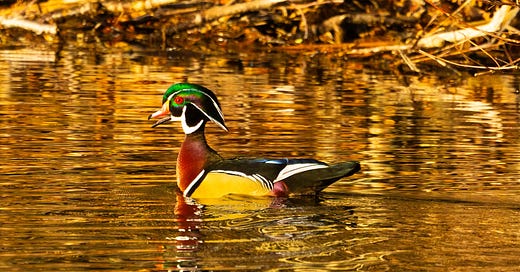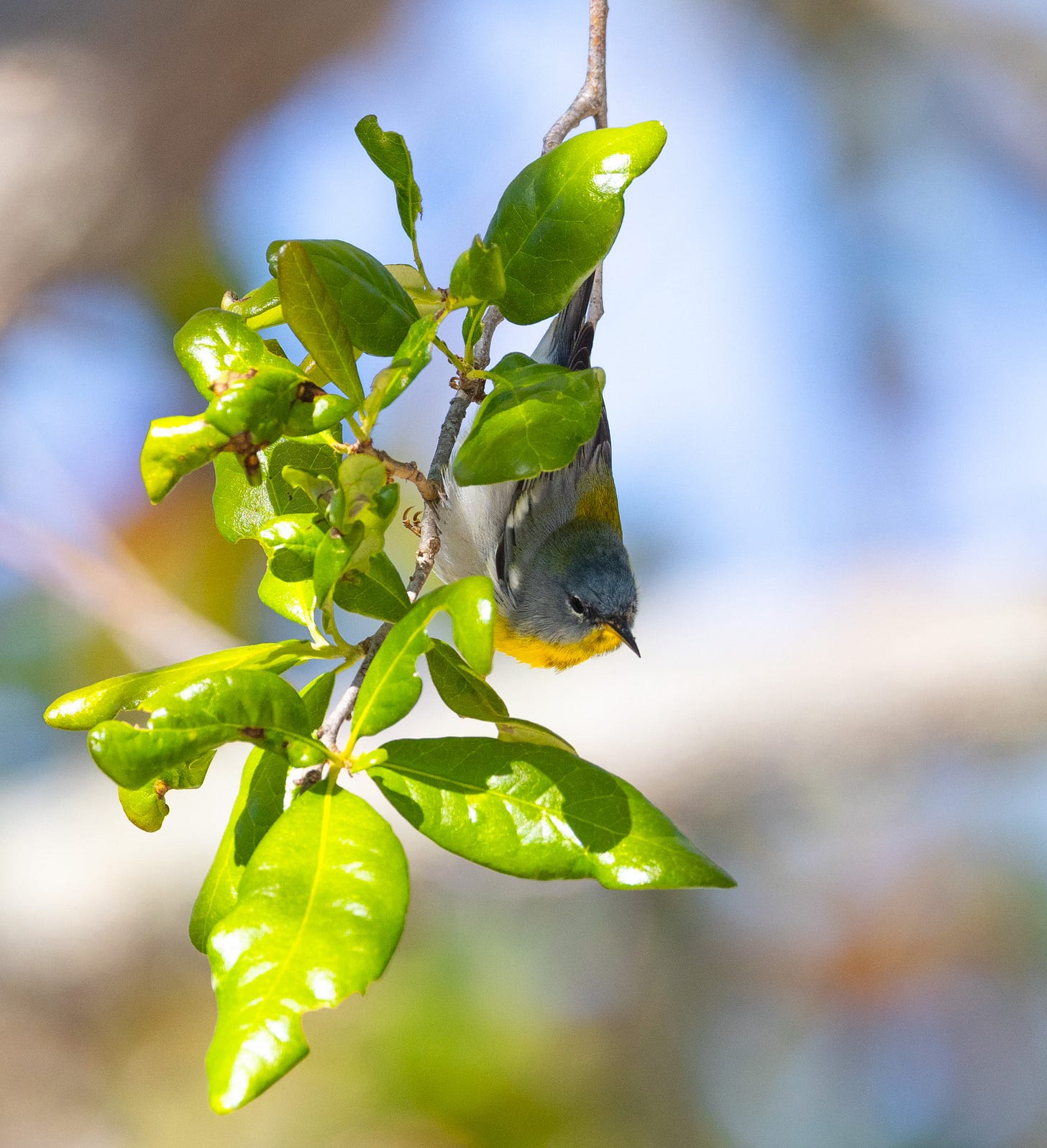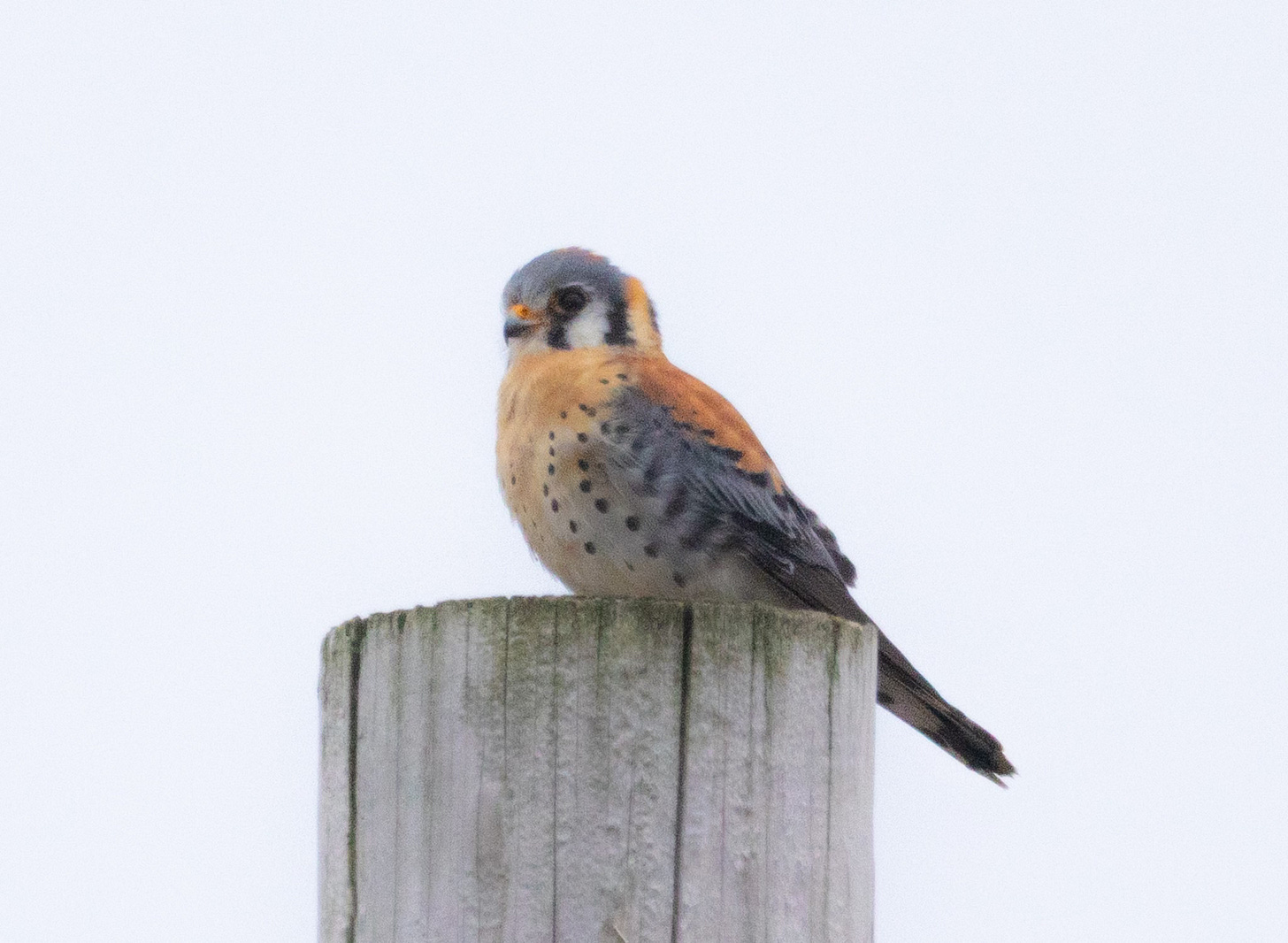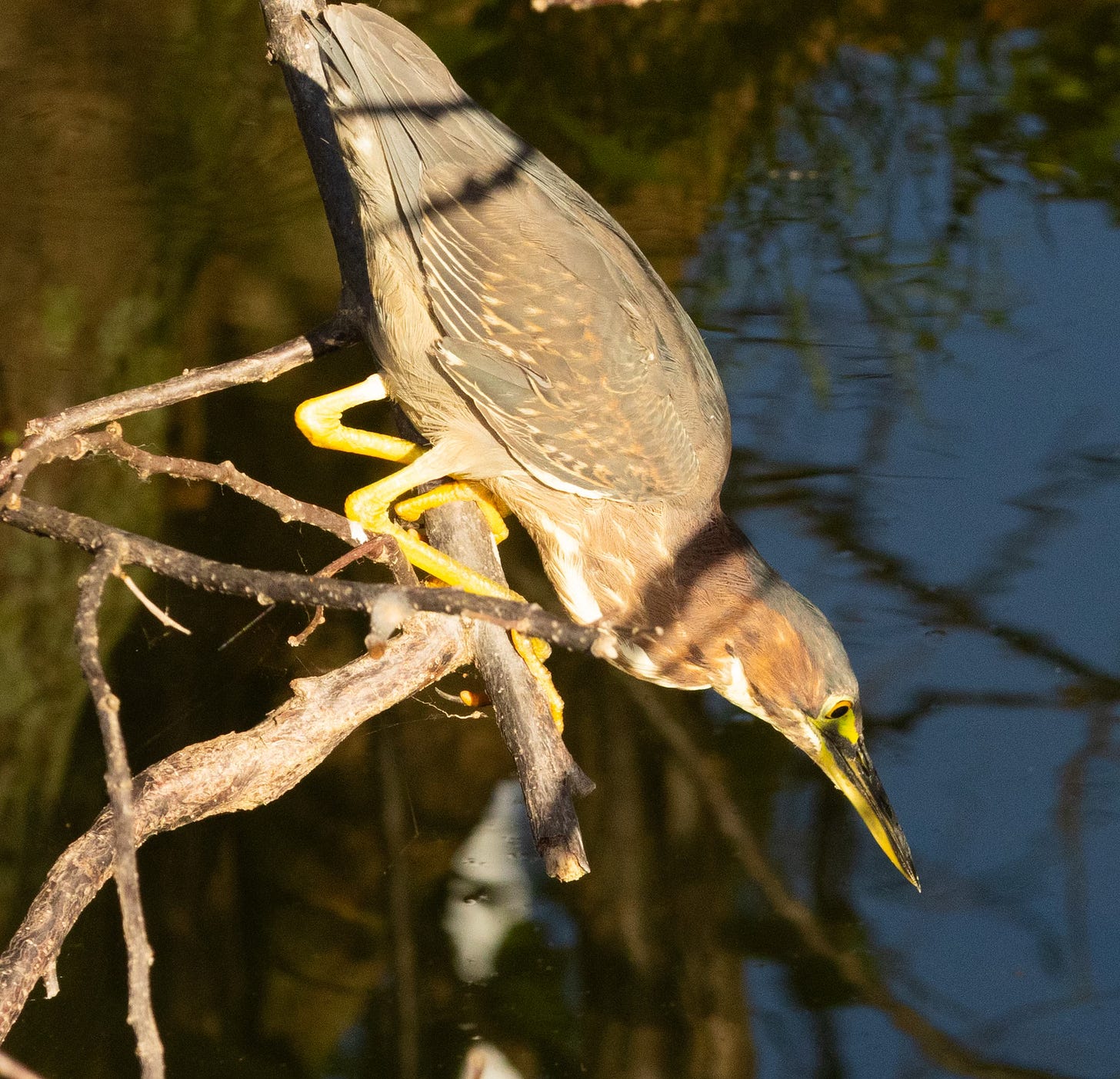1. Let's begin with a fascinating look at the Red-tail Hawk's 16 (!) subspecies: We’ve all done it. Maybe you’re whizzing down the freeway when a bulky shape in a roadside tree catches your attention. Your eye and brain make a quick assessment, then you go back to fiddling with your GPS or playlist. Maybe you’re out birding when a distant raptor silhouette appears on the horizon. You flick up your binoculars for a quick, confirming glance, then drop them just as fast. Why did you move on immediately? Because in each case, you thought to yourself: Eh, just a red-tail. Bryce Robinson would like to explain to you why Red-tailed Hawks are not boring birds. Far from it. (via Living Bird)
2. Articles like this one will be as close as we all get to one of America's rarest birds: In the middle of Alaska’s Bering Sea,St. Matthew Island and its much smaller neighbor Hall Island are among the few specks of land amid hundreds of square miles of water. These uninhabited volcanic isles host an impressive array of Arctic birds, including one of North America’s most enigmatic species: the McKay’s Bunting, which breeds only here. Last summer a team of scientists made a rare expedition to St. Matthew, voyaging more than 500 miles from the Aleutian Islands to conduct the third-ever McKay’s Bunting survey. They had a week to scour an island six times the size of Manhattan for the songbirds—a critical step for investigating what they worry is an ongoing population decline. (via Audubon)
By Hap Ellis, Wood Duck - Brookline, MA.
3. From Audubon, a shout-out to the Blackpoll Warbler and its remarkable migration, but also the importance of North America's Boreal Forest: The Blackpoll Warbler has the longest migration of any warbler and, in fact, the longest migration of any Boreal songbird. Every year, Blackpoll Warblers make an incredible journey from North America’s Boreal Forest to South America. Some may choose to take short breaks in Bermuda or the Antilles along the way, while others appear to fly nonstop for three days (or more) to reach their seasonal southern homes. The fact that these small birds weighing less than half an ounce are flying amazing distances continuously for over 72 hours is enough to fascinate most bird enthusiasts, but there are other features to the Blackpoll’s migration that are just as interesting. (via Audubon)
4. Last week we noted the passing of a legend, Victor Emanuel; the NY Times had a wonderful obituary this week: Victor Emanuel, a renowned birder whose adventures around the world in pursuit of imperial woodpeckers, red-crowned cranes and other avian wonders were chronicled by George Plimpton, Peter Matthiessen and Rose Styron, died on March 11 in Austin, Texas. He was 84. Mr. Emanuel made a business out of his reverential regard for birds when he founded Victor Emanuel Nature Tours in 1976. (“When he comes to New York for a visit,” Mr. Plimpton once noted in Audubon magazine, “he arrives at our apartment with a pair of binoculars hanging from his neck.”) Among the first to specialize in ecotourism, his company, based in Austin, employs dozens of guides who lead hundreds of expeditions a year. In addition to writers, Mr. Emanuel’s bird-watching companions included Prince Philip, the filmmaker Terrence Malick and former President George W. Bush and his wife, Laura, who was a promoter of conservation efforts in Texas. (via The New York Times)
5. "(F)ew places can deliver like a tree cavity" - a fun look at woodpeckers' handiwork: When night falls in the forest, most birds tuck into nooks where they can feel secure—the V-shaped intersection of two tree boughs, a cluster of dense branches. Some may take to the eaves of nearby houses. Brown Creepers find a piece of shaggy bark to wedge their bodies under. And many birds—sometimes more than half the species in a given woodland—stow themselves safely into a place we humans rarely (and barely) get to see: inside the hole of a tree. Whether it’s a fragment of forest bordering an urban neighborhood, or an old-growth stand that’s been regenerating itself for millennia, tree cavities are a common and crucial part of habitat in every forest landscape. When it comes to a cozy home, few places can deliver like a tree cavity, says Kevin McGowan, instructor for the Cornell Lab of Ornithology Bird Academy course The Wonderful World of Woodpeckers. McGowan says a big part of recognizing the contribution of woodpeckers to an ecosystem begins with understanding the value of a hole. (via Living Bird)
6. Discouraging - a quick look at the 2025 state of Arizona's birds: Birds that call Arizona's desert ecosystem home — including the state's iconic cactus wren — are in serious decline, according to a sweeping new conservation report. Birds are indicators of the overall health of their habitats and signal early warnings of broader trouble. If these habitats can't support birdlife, they likely can't sustain other wildlife — or even humans — for long. Since 1968, the West has lost almost half of aridland bird habitat to drought, wildfires and invasive plants, per the North American Bird Conservation Initiative's 2025 State of the Birds report. Nearly a quarter of the 31 aridland birds included in the analysis are considered "tipping point" species, meaning they could vanish without urgent conservation action. This includes the sagebrush sparrow, black-chinned sparrow and Pinyon Jay, which can be found in parts of Arizona. (via Axios Phoenix)
By Hap Ellis, Northern Parula - Durante Park, Longboat Key, FL.
7. "Hummingbird Central" - tracking their migration across the country: As North America emerges from winter, hummingbirds are embarking on great migrations that could pass through your area soon. The small birds, known for their long beaks and ultra-fast wings that make them look like they're floating, begin heading north in late winter. Some species, like the Calliope Hummingbird, travel more than 5,000 miles each year, according to the American Bird Conservancy. As flowers begin to bloom and give the little birds some nourishment, you might just start seeing them in your own backyard. Throughout April, birdwatchers from California to Maine report hummingbird sightings, according to Project FeederWatch by the Cornell Lab of Ornithology and Birds Canada. Check out what parts of the country the birds might be headed to next. (via USA Today)
8. One of our favorite birds chronicled this week in the Palm Beach Post (great pics): They're the acrobats of the skies, the birds that look as though they're somehow defying gravity when conducting aerial maneuvers. Swallow-tailed kites arrived in Florida a few weeks ago, and now is the prime time for seeing one of these majestic birds. People here often see them flashing overhead during the spring months as they hunt just above the tree canopies and hover over open spaces. A white-and-black, mid-sized raptor with a deeply forked tail, swallow-tailed kites (Elanoides forficatus) are arguably the most acrobatic and athletic of birds found in the Sunshine State. And they will be gliding, swooping, flipping and twisting overhead for the next four months. (via The Palm Beach Post)
9. Fun piece from one of our favorite New England columnists, what's in a name?: I was in the dentist’s office recently, reclining for an hour in the hygienist’s chair with no other duties but to rinse and spit. My mind wandered, as it often does. Suddenly, it hit me. America’s recent desire to take over Canada is partially the fault of the birding community. Just look at the way we name birds. In Maine, you can find American wigeons, American black ducks, American coots, American oystercatchers, American golden-plovers, American woodcocks, American bitterns, American three-toed woodpeckers, American pipits, American kestrels, American crows, American robins, American goldfinches, American tree sparrows and American redstarts. You can also find Canada warblers, Canada jays and Canada geese. How did it happen that some birds are named after a country — Canada — but others are named American, as if they are somehow possessed by our country, or are at least specifically associated with it? Or maybe they are just more patriotic than similar birds? (via Bangor Daily News)
By Hap Ellis, American Kestrel - Millennium Park, Boston, MA.
10. A hidden gem - the "Ding" Darling NWR: Don’t forget your camera and binoculars when visiting J.N. “Ding” Darling National Wildlife Refuge. The place is world-renowned for its spectacular views of birds and wild animals. People from all over the world visit the Sanibel Island preserve to watch herons, pelicans and many other birds; snap wildlife photos; and generally bask in the glory of nature — especially on its popular Wildlife Drive. Sometimes that includes TV news crews, too. The popular news-magazine show “CBS Sunday Morning” sent a camera crew in 2023 for its weekly end-of-show nature segment. The 3-minute clip showed off some of the refuge’s coolest critters, including a bobcat grooming itself, a lazy alligator and an Anhinga bird drying its wings in mangroves. (via News-Press)
11. Podcast #1 - For your listening pleasure - a MPB podcast on Spring birding: Springtime means the return of waterfowl, shorebirds and songbirds to Maine. But a warming climate means that some birds have stayed here all winter. We'll learn about changes and threats to bird populations, as well as avian flu's impacts on wild birds. And we'll talk about what birds to look for, where to go, and which rare birds have been spotted recently. (via Maine Public Radio)
12. Podcast #2 - The importance of eBird and "volunteer data" - NPR's podcast on the 2025 State of the Birds report: Some of the best songs you can hear this spring aren't on the radio. Hundreds of millions of birds make their annual migration back into North America in early March. Despite their return to our neighborhoods and backyards to wake us up bright and early, a new report reveals they're numbering fewer and fewer. The 2025 State of the Birds report is a joint effort spearheaded by a coalition of science and conservation organizations. It found widespread population decline across nearly all habitats and that over one third of species require conservation help. But it's not all bad news. The report also finds that an increased interest in birding has led to more volunteer data that helped shaped the report. What can we learn about our feathered friends and our environment while watching? (via National Public Radio)
13. Potatoes for your feeders - who knew?: As spring arrives in our yards, so do many wonderful birds who migrated for winter or simply stayed hidden from the cold weather. It's around this time you may be wondering what is best to feed them? Well, bird experts say you should put cooked potato in your bird feeder. Cooked potatoes can be a nutritious snack for birds, and a vital way to help garden birds in summer and spring. When it comes to bird feeders, it's also vital to know what not to feed birds so you don't cause any harm to the wildlife coming to your yard. And potatoes must be prepared in the correct way for birds, otherwise it can be unsafe for them to eat. Here's why you should feed birds cooked potato, how to do it correctly avoid causing them any harm. (via Homes and Gardens)
By Hap Ellis, Green Heron - Wakodahatchee Wetlands, Delray Beach, FL.
14. A new celebrity in DC: Move over, Eaglecam — there's a new celebirdie in town: a gorgeous Painted Bunting. The male songbird is rare in these parts and "incomparably beautiful," per birding site Ebird, causing enthusiasts to flock to Georgetown. Sir Bunting has been spotted in Oak Hill Cemetery, posing artfully on the bird fountain and among pink blossoms like the little showboat he is. Typically, the colorful birds stick to warmer climes in the south. Another Painted Bunting drew hundreds to Great Falls in 2021. Between the fleeting magnolia and cherry blossoms, and the rare bird, Oak Hill is D.C.'s best spring photo opp. (via Axios Washington D.C.)
15. Finally, BNI is a big fan of the Netflix series "The Residence" - so we were delighted to find this piece on "(Almost) Every Bird Mentioned..." in the series: If there’s one thing Miss Cordelia Cupp loves, it’s a bird. It’s no coincidence that the very first time we meet the witty world-famous detective played by Uzo Aduba in The Residence, she’s not detecting (isn’t that what detectives do?). She’s birding. And on her way to the crime scene, she’s not talking about, well, a crime. Instead, she’s passionately explaining to Chief of Police Larry Dokes (played by Isiah Whitlock Jr.) how President Teddy Roosevelt was a prominent birder before becoming president and how he kept a journal of every bird he saw on White House grounds. In fact, she’s making the list and checking it twice. Here is a list of every bird mentioned in the eight-part whodunit. If you’re feeling bold, don’t hesitate to take a sip of your chosen beverage each time you hear a bird’s name during the course of the show. Happy watching! (via Shondaland)
Bird Videos of the Week
Video by Birdwatching Dot Calm, “American Woodcock in New York City”.
Cornell Live Bird Cam - Snow Bunting.
Cornell Live Bird Cam - Egg #3 has arrived at the Cornell Hawks nesthttps://www.instagram.com/p/DH_Kyd-CSB4/?hl=en!








